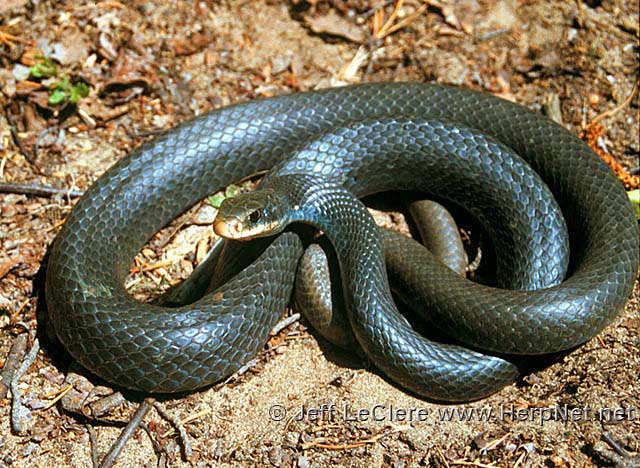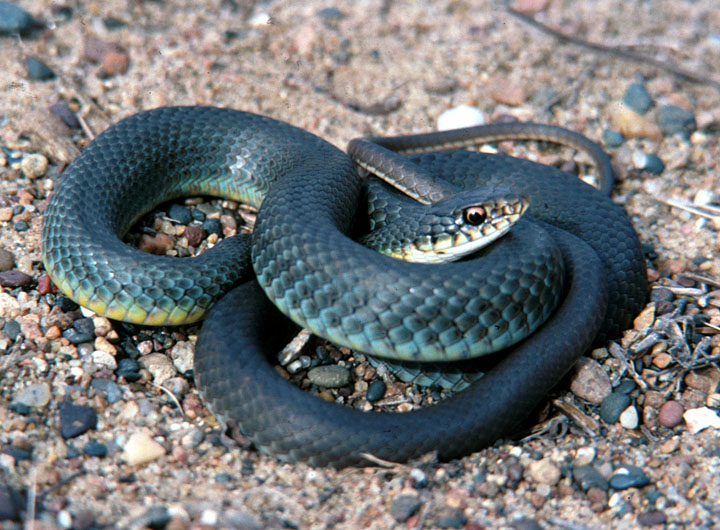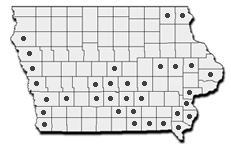North American Racer (Coluber constrictor)
by Jeff LeClere

Status
PROTECTED and Species of Greatest Conservation Need. It is illegal to kill or collect this species by law in Iowa.
Description
Harmless to humans. The North American racer is a large Iowa species measuring between 23-50 inches (58-127 cm) in length. Max 70 inches (177.8 cm; Conant and Collins 1998). Adults are uniform gray, blue, bluish black, greenish, or light brown, with no trace of head or dorsal markings. The belly is dirty white, porcelain, or yellow with no markings. The throat and neck are bright yellow and the chin and upper labials may be yellow or white. Some specimens from Lee County are velvety black with light bellies. Racers have smooth scales and divided anal plates. The young are much different from adults and have a white or gray ground color with black, brown, or reddish blotches. The belly is white with small brown or reddish spots and the tail is uniformly brown and unmarked.

Subspecies
The eastern yellow-bellied racer, Coluber constrictor flaviventris and the blue racer, Coluber constrictor foxii are the two subspecies found in Iowa. The blue racer was not recognized recently for a brief period of time and is still not recognized by some taxonomists. The two subspecies are similar to one another and individuals resembling either subspecies may be found anywhere throughout their Iowa range.

Similar Species
Western rat snakes have weakly keeled scales, a divided anal plate, and usually have traces of a pattern. Plainbelly (copperbelly) water snakes have keeled scales and orange red belly and lip scales. Young racers can be differentiated from all other small spotted snakes found in Iowa by their smooth scales, divided anal plate, and an unmarked brown tail. Most other small spotted snakes in Iowa have banded tails to the tip.

Range
The racer is found nearly statewide in Iowa, though it appears to be absent from parts of north central Iowa.


Habitat
Racers are active from late April to October. Open prairie, sand prairie, woodland edge, and bluff prairies are preferred. They also like old fields, grasslands, ditches, and railroad grades adjacent to these habitats. Racers are common throughout nearly all of Iowa, but the open habitats they prefer are quickly disappearing. They will benefit from preservation of grassland and oak savanna habitats as well as preservation or management for timber rattlesnakes and bullsnakes, species with which they often share habitat.
Habits
Racers are the quickest and most visually oriented snakes in Iowa. Active hunters, they move quietly through grass and brush in search of food. These snakes are diurnal even in hot weather. This thermoregulatory habit enhances their ability to chase down and capture fast moving prey. On cool rainy days, racers may take shelter under rocks, logs, boards, or in rocky crevices. They spend the winter below the frost line, often with other species of snakes such as garter snakes, milk snakes, bullsnakes, timber rattlesnakes, western fox snakes, and other racers, particularly in bluff prairie habitats.
When threatened, this species can flee with incredible speed and they appear to have good home range orientation as they will slither, often toward an intruder, into a preferred hiding spot. Some people contend that racers will chase them. This is a myth, but I have had them slither toward me, only to shoot down a familiar burrow just past me. This may produce the illusion that they are “chasing” someone. Although they can move at speeds up to 5.6 kmph, humans can run much faster than racers can move (Mosauer 1932). When cornered, however, they may raise their head, strike, and thrash their tails. The tail movement is much slower when compared to the faster tail vibrations of Iowa’s constricting and venomous snakes. Generally, if they are picked up, they will musk, defecate, and bite. However, I have seen some specimens curl up in a ball and hide their head in their coils. I have observed this behavior on both hot and cool days alike.

Reproduction
Courtship and mating occur in spring soon after emergence. The male locates the female by scent. Sometimes a chase ensues. Dr. Jim Christiansen and I were checking drift fences in Muscatine County one spring and witnessed a large racer shoot past us, easily glide over the drift fence, and climb right up a tree, quickly followed by another large racer. The male crawls alongside and on top of the female. The female will raise her tail when she is ready to breed. Breeding may take an hour or more. The female lays 5-25 eggs in June or July in burrows, sand, rotting stumps, compost piles or other humid chambers. The eggs do not adhere to one another as in some other snake species and are granular feeling because of salt like particles on the shell. Hatching occurs in August or September. Maturity is reached in two or three years. The color change from young to adult occurs rapidly during the second year.

Food
This snake probably has the most diverse diet of any Iowa snake. They will eat just about anything they can chase down. Food items include: rodents, insects, frogs, toads, lizards, snakes, reptile eggs, birds, and birds’ eggs. Despite their scientific name, they are not constrictors, but they may use a loop or two of their coils to press victims to the ground. Large prey are shaken violently and rapidly chewed upon using their strong jaws, while smaller food is simply swallowed alive. I have found the fecal matter of many wild racers to be comprised largely of locust exoskeletons (LeClere, 1996). Many people have witnessed racers chasing and consuming prairie racerunners (not an easy task), and other snakes. On two occasions, young western fox snakes were being consumed by racers when they were discovered (Jessen, 1993; Bergquist, personal communication) and a large red-sided garter snake on another (Kaufman, personal communication). These events took place in Minnesota. I have observed young racers eating small brown and redbelly snakes.
